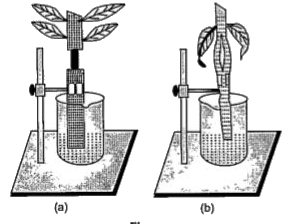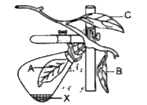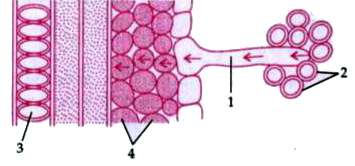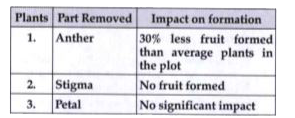When some parts of the stem, both the fresh shoots of a green herbaceous plant have been removed and lower end is dip in the water. The diagram given below represents the result of the experiment.

The plants die due to wilting because :
available light is reduced to half
xylem is blocked
a few roots are broken
phloem is blocked
The correct Answer is:B
When availability of water is low under the soil, the water chains in the xylem become thinner and thinner. Effectively, the plant is losing water faster than absorbing it. When this happens, the plant loses its turgidity and begins to wilt.
Topper's Solved these Questions
Similar Questions
The diagram below represents an experiment to demonstrate a particular aspect of a physiological process in plants. Study the diagram and answer the questions that follows:

In what way will the three leaves A, B and C differ at the end of the experiment when tested with iodine solution?
View SolutionThe figure given below is a diagrammatic representation of a part of the cross section of the root in the root hair zone. Study the same and then answer the questions that follow :

Due to an excess of this pressure sometimes drops of water are found along the leaf margins of some plants especially in the early mornings. What is the phenomenon called ?
View Solution
Knowledge Check
The ocean will not look the same color in the future. Essentially, climate change will make the blues of the ocean bluer and the greens greener. Scientists from MIT, Boston, figured this out by creating a global model that simulates the growth of a tiny creature that lives in the oceans and affects the color we see. The ocean looks blue or green to us because of a combination of how sunlight interacts with water molecules and with whatever else lives in that water. The molecules in water absorb all but the blue part of the spectrum of sunlight, a nd the water reflects that blue color back. That's the color we see. The water looks greener when it has more phytoplankton, tiny, microscopic organisms that, like plants, can use chlorophyll to capture mostly the blue portions of the spectrum of sunlight. They then use photosynthesis to create the chemical energy they need to live. When there are more of these creatures in the water absorbing sunlight, they make the water look greener. Conversely, if there are fewer phytoplankton, the water looks bluer. The creatures' growth is dependent on how much sunlight, carbon dioxide and nutrients are around. Climate change is altering the ocean currents, meaning there will be fewer nutrients for phytoplankton to feed on in some areas, so there will be a decline in their number in those regions. Since the 1990s, satellites have taken regular measurements of how much chlorophyll is in the ocean. Those levels can change because of weather events or because of climate change. The study predicts that the blues will intensify, most likely in subtropical regions where phytoplankton will decrease. These are areas near the e quator like Bermuda and the Bahamas that are already quite low in phytoplankton. Regions where there are a lot of nutrients, like in the Southern Ocean or parts of the North Atlantic, will see even faster-growing phytoplankton b ecause those w aters are warming with climate change. Those waters will look greener. Climate change will bring a color change to half of the world's oceans by the end of the 21st century, the study says. That's bad for climate change on several levels: For one, phytoplankton remove about as much carbon dioxide from the air as plants and help regulate our climate, research shows. They are also key to other animals' survival. "Phytoplankton are at the base, and if the base changes, it endangers everything else along the food web, going far enough to the polar bears or tuna or just about anything that you want to eat or love to see in pictures."said Stephanie Dutkiewicz, a principal research scientist in MIT.
Which statement is not true according to the passage?ABy the end of the 21st century the colour of ocean waters will change.BIn subtropical regions phytoplankton will decrease.CMore blue colour in the ocean will affect climate change.DPhytoplankton has a key role in the survival of o ther animals.A passage is given with five questions following it. Read the passage carefully and select the best answer to each question out of the given four alternatives.
A plant species that has outlived the dinosaurs, the Cycas circinalis, a 'living fossil' found only in the Western Ghats, faces the threat of extinction due to the over-harvesting of its leaves for commercial purposes.
While there are nine species of Cycas found across the country, almost all of which are classified as being endangered, the Cycas circinalis, found at altitudes between 1,500 and 1,800 meters, has traditionally been used by tribal communities for a variety of purposes. In the Nilgiris and other parts of the Western Ghats, where the plant is found, the seed is sometimes soaked in water (to remove a strong poison contained within) and ground into flour, after which it is eaten, while the seed is also said to be used in traditional, indigenous medicine.
However, over the last few decades, the leaves of the circinalis, which are used for ornamental purposes like for setting up 'pandals' have been harvested in bulk from the remaining plants, often leading to them becoming stunted and unable to reproduce and increase in number. With a single leaf costing as much as ? 25, the economic incentive to completely strip the plant of all its leaves in one harvest remains high for most people.
Shiny Miriam Rehel, Programme Co-ordinator for the Biodiversity Restoration Programme at Keystone Foundation, speaking to The Hindu, said that circinalis plants do not grow in large numbers in the wild, and the over exploitation of the leaves from the plant has caused a further decline over the last few decades.
The Keystone Foundation has been trying to promote the conservation of the species by encouraging forest-dependent communities to sustainably harvest the leaves from the circinalis. "We collect the seeds from the wild and raise it at our nursery on the Keystone campus. We then encourage farmers and tribal communities to grow the plants near to their dwellings or land holdings," said Ms. Rehel, who added that the conservation of the species needs to be assured through working with local communities, creating awareness of sustainably harvesting the leaves and ensuring that the plant itself remains healthy. Speaking of their importance, Ms. Rehel said that not only the conservation of the endangered circinalis important to protect the livelihood of tribal communities, but also for biodiversity.
She said that the circinalis is an ideal host plant for ants, cupid butterflies and bats, and added that their protection will be a vital aspect of protecting the ecology of the Western Ghats in the long run.
What else other than over-harvesting has contributed in decline of Cycas circinalis?AConsumption by wildlifeBThe small scale growth of the plantCThe high cost of the plantDThe pollution of air and waterA passage is given with five questions following it. Read the passage carefully and select the best answer to each question out of the given four alternatives.
A plant species that has outlived the dinosaurs, the Cycas circinalis, a 'living fossil' found only in the Western Ghats, faces the threat of extinction due to the over-harvesting of its leaves for commercial purposes.
While there are nine species of Cycas found across the country, almost all of which are classified as being endangered, the Cycas circinalis, found at altitudes between 1,500 and 1,800 meters, has traditionally been used by tribal communities for a variety of purposes. In the Nilgiris and other parts of the Western Ghats, where the plant is found, the seed is sometimes soaked in water (to remove a strong poison contained within) and ground into flour, after which it is eaten, while the seed is also said to be used in traditional, indigenous medicine.
However, over the last few decades, the leaves of the circinalis, which are used for ornamental purposes like for setting up 'pandals' have been harvested in bulk from the remaining plants, often leading to them becoming stunted and unable to reproduce and increase in number. With a single leaf costing as much as Rs 25, the economic incentive to completely strip the plant of all its leaves in one harvest remains high for most people.
Shiny Miriam Rehel, Programme Co-ordinator for the Biodiversity Restoration Programme at Keystone Foundation, speaking to The Hindu, said that circinalis plants do not grow in large numbers in the wild, and the over exploitation of the leaves from the plant has caused a further decline over the last few decades.
The Keystone Foundation has been trying to promote the conservation of the species by encouraging forest-dependent communities to sustainably harvest the leaves from the circinalis. "We collect the seeds from the wild and raise it at our nursery on the Keystone campus. We then encourage farmers and tribal communities to grow the plants near to their dwellings or land holdings," said Ms. Rehel, who added that the conservation of the species needs to be assured through working with local communities, creating awareness of sustainably harvesting the leaves and ensuring that the plant itself remains healthy. Speaking of their importance, Ms. Rehel said that not only the conservation of the endangered circinalis important to protect the livelihood of tribal communities, but also for biodiversity.
She said that the circinalis is an ideal host plant for ants, cupid butterflies and bats, and added that their protection will be a vital aspect of protecting the ecology of the Western Ghats in the long run.
Why cycas circinalis faces the threat of extinction?ABecause of its low productionBBecause of excessive cattle grazingCBecause of over-harvesting of its leavesDBecause of pests
The given diagram represent the structure of a flower. Study the structure

A student decides to study the impact of removing certain flower parts on fruit formation in plant species X. He chooses three separate plants that are growing in the same plot under uniform conditions. The data is given in the table below.

Which of the following can be inferred from the above data?
View SolutionIn this section each item consists of six sentences of a passage. The first and sixth sentences are given in the beginning as S1 and S6. The middle four sentences in each have been jumbled up and labelled P, Q, R and S. You are required to find the proper sequence of the four sentences
S1 : Harsten's theory was that plants definitely react to music
S6 : He found that this plant grew faster and 70 percent taller than the other plant.
P : In his experiment, he used two banana plants.
Q: The music was in fact a high-pitched humming sound.
R : He gave both plants the same light, heat and water.
S :But for about an hour a day, one of the plants 'listened' to some music.
The proper sequence should be.
View SolutionSome experiments were carried out using Croton sp. plants to understand the process of photosynthesis. It was observed that the leaves of the plant exposed to light for longer duration accumulated more starch. However, due to presence of pre-formed starch in the leaves, it was difficult to find the net productivity on a fixed exposure to light source. Therefore, it was necessary to obtain starch free leaves in the plant before starting the experiment.
The equation given below represents photosynthesis. Identify P and Q.
P+watersunlight−−−−−−→chlorophyllglucose + Q
View SolutionRead the following passage and answer the questions given after it. The ocean will not look the same color in the future. Essentially, climate change will make the blues of the ocean bluer and the greens greener. Scientists from MIT, Boston, figured this out by creating a global model that simulates the growth of a tiny creature that lives in the oceans and affects the color we see. Their research was published in the journal Nature Communications.
The ocean looks blue or green to us because of a combination of how sunlight interacts with water molecules and with whatever else lives in that water.
The molecules in water absorb all but the blue part of the spectrum of sunlight, and the water reflects that blue color back. That's the color we see.
The water looks greener when it has more phytoplankton, tiny, microscopic organisms that, like plants, can use chlorophyll to capture mostly the blue portions of the spectrum of sunlight. They then use photosynthesis to create the chemical energy they need to live. When there are more of these creatures in the water absorbing sunlight, they make the water look greener. Conversely, if there are fewer phytoplankton, the water looks bluer.
The creatures' growth is dependent on how much sunlight, carbon dioxide and nutrients are around. Climate change is altering the ocean currents, meaning there will be fewer nutrients for phytoplankton to feed on in some areas, so there will be a decline in their number in those regions.
Since the 1908, satellites have taken regular measurements of how much chlorophyll is in the ocean. Those levels can change because of weather events or because of climate change.
The study predicts that the blues will intensify, most likely in subtropical regions where phytoplankton will decrease. These are areas near the equator like Bermuda and the Bahamas that are already quite low in phytoplankton.
Regions where there are a lot of nutrients, like in the Southern Ocean or parts of the North Atlantic, will see even faster-growing phytoplankton because those waters are warming with climate change. Those waters will look greener.
Climate change will bring a color change to half of the world's oceans by the end of the century, the study says. That's bad on several levels: For one, phytoplankton remove about as much carbon dioxide from the air as plants and help regulate our climate, research shows.
They are also key to other animals' survival" Phytoplankton are at the base, and if the base changes, it endangers everything else along the food web, going far enough to the polar bears or tuna or just about anything that you want to eat or love to see in pictures, "said Stephanie Dutkiewicz, a principal research scientist in MIT.
In which areas will the ocean look bluer?
View SolutionRead the following passage and answer the questions given after it. The ocean will not look the same color in the future. Essentially, climate change will make the blues of the ocean bluer and the greens greener. Scientists from MIT, Boston, figured this out by creating a global model that simulates the growth of a tiny creature that lives in the oceans and affects the color we see. Their research was published in the journal Nature Communications.
The ocean looks blue or green to us because of a combination of how sunlight interacts with water molecules and with whatever else lives in that water.
The molecules in water absorb all but the blue part of the spectrum of sunlight, and the water reflects that blue color back. That's the color we see.
The water looks greener when it has more phytoplankton, tiny, microscopic organisms that, like plants, can use chlorophyll to capture mostly the blue portions of the spectrum of sunlight. They then use photosynthesis to create the chemical energy they need to live. When there are more of these creatures in the water absorbing sunlight, they make the water look greener. Conversely, if there are fewer phytoplankton, the water looks bluer.
The creatures' growth is dependent on how much sunlight, carbon dioxide and nutrients are around. Climate change is altering the ocean currents, meaning there will be fewer nutrients for phytoplankton to feed on in some areas, so there will be a decline in their number in those regions.
Since the 19908, satellites have taken regular measurements of how much chlorophyll is in the ocean. Those levels can change because of weather events or because of climate change.
The study predicts that the blues will intensify, most likely in subtropical regions where phytoplankton will decrease. These are areas near the equator like Bermuda and the Bahamas that are already quite low in phytoplankton.
Regions where there are a lot of nutrients, like in the Southern Ocean or parts of the North Atlantic, will see even faster-growing phytoplankton because those waters are warming with climate change. Those waters will look greener.
Climate change will bring a color change to half of the world's oceans by the end of the let century, the study says. That's bad on several levels: For one, phytoplankton remove about as much carbon dioxide from the air as plants and help regulate our climate, research shows.
They are also key to other animals' survival" Phytoplankton are at the base, and if the base changes, it endangers everything else along the food web, going far enough to the polar bears or tuna or just about anything that you want to eat or love to see in pictures, "said Stephanie Dutkiewicz, a principal research scientist in MIT.
Where do phytoplankton grow profusely?
View Solution
